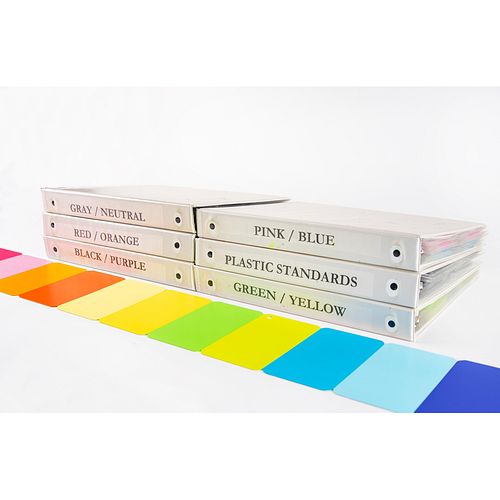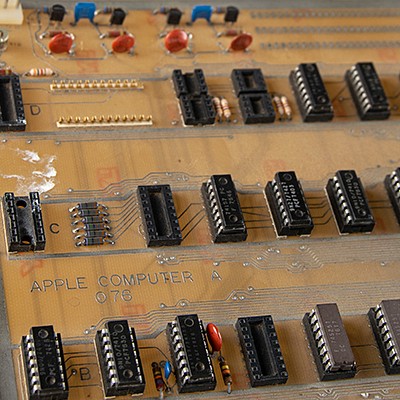Robert Flores: Apple 'Color Guru' Personal Color Swatch Archive
Two ways to bid:
- Leave a max absentee bid and the platform will bid on your behalf up to your maximum bid during the live auction.
- Bid live during the auction and your bids will be submitted real-time to the auctioneer.
Bid Increments
| Price | Bid Increment |
|---|---|
| $0 | $5 |
| $50 | $10 |
| $200 | $25 |
| $500 | $50 |
About Auction
Aug 18, 2022
RR Auction support@rrauction.com
- Lot Description
One-of-a-kind color swatch archive from the career of Bob Flores, the 'color guru' who developed the iconic palettes for Apple products such as the iMac, iPod, and iPhone. Flores got his start in the hot rod world, doing automotive airbrushing and pinstriping, before opening a San Francisco paint shop focused on business signage. He made his unlikely entry into the tech industry in 1996, when an Apple color consultant was referred to him to figure out how to perfect the metallic sheen of the Twentieth Anniversary Macintosh.
The 1997 return of Steve Jobs to Apple brought forth the iMac, and Flores' career as a premier industrial colorist began in earnest. Impressed by his expertise and fresh approach to color, Jobs relied on Flores to develop the bright, candy-like hues for the iMac line. These colors proved essential to the product's initial marketing campaigns, which included a TV ad featuring 'She's a Rainbow' by the Rolling Stones: gleaming iMacs tumble across the screen as Mick Jagger belts the chorus, 'She's like a rainbow / Coming, colors in the air / Oh, everywhere / She comes in colors.' A promotional poster of the flashy fruit-themed desktops—available in blueberry, grape, tangerine, lime, and strawberry—simply punctuated "Yum.," was also produced (an original copy from Flores's collection is included). The iMac became a bestselling sensation, and competitors followed suit with high-style computers of their own. Thus was the death knell of the beige PC.
Flores developed his colors on pieces of aluminum and acrylic that were cut and fabricated in his shop. Each color was formulated with a documented recipe (color toner amounts in grams), mixed, and sprayed on this material with adjusted gloss levels. He worked directly with Apple's designers to conceive and create these colors, drawing inspiration from wherever it could be found. In one case, an industrial designer brought him out to see whether he could match the tone of the early morning sun hitting an office window. Once the colors were developed and approved, the formulations were provided to the plastic manufacturer so that they could produce cases for Apple's innovative hardware. Even as Apple graduated from rainbow-hued iMacs to stark white iPods and silver MacBooks, these colors were painstakingly developed using the same processes—seen in the dozens of iterations of whites, grays, and blacks within Flores's color swatch binders. When the iPod Mini reintroduced the rainbow to Apple's sleek-and-shiny product line, Flores developed those colors, too.
The primary contents of the archive are eight binders containing over 500 of these color swatches, mostly 3″ x 5″, organized by Flores himself. Many of the color panels have Apple Computer labels on the reverse identifying the affiliated project, either by codename (e.g. "M17," "M26" [iPod Nano], "M42" [MacBook], "M68" [first-gen iPhone], "M82" [MacBook Air], "Q21B," "Q91," "Q98" [fifth-gen iPod], "Q72" [iBook G4], "Q88" [Mac Mini]) or codename and product (e.g. "Q35 ibook color project," "Q54 anodized power book," "Q22 iPod mini," "Q79 tablet," "N82/P3 iPhone"). Many of these are especially interesting as they represent pre-release, experimental samples of color possibilities for some of the most important consumer products of today's technological age: the original iPhone, colorful iPods, and MacBooks of every variety. Others lend insight into unrealized possibilities—Apple never produced a color PowerBook line, nor did they make a red iPod Mini or neon MacBook Air. Colors were under consideration for the "Q79 tablet" in 2004, some six years before the introduction of the iPad. Furthermore, these panels demonstrate the visual and tactile changes made by slight adjustments to paint formulations: the differences between "Tangerina 30%," "Tangerina 60%," "Tangerina 100%," and "Tangerina 100% hi-gloss" are quite striking. Many also indicate their Pantone, Toyo, or Munsell codes.
The binders are broken down as follows:
Book 1 (Plastic Standards, c. 2002-2007): 27 plastic panels in various opaque colors (blacks and grays with names like "Mist 20," "Accessory Black," "Moon Gray 5," and "Moon Gray 10"), as well as transparent pieces demonstrating varying levels of a "Frost Effect." Many bear Apple labels differentiating the samples as "Development Standard," "Production Standard," "Master Standard," or "For Visual Comparison Only," while others are unlabeled.
Book 2 (Pink/Blue, c. 2003-2005): 34 pink panels and 50 blue panels, with names like "Pink Solid Double Intensity," "Mini Pink," "Rhod Red," "Pinku 30% hi-gloss," "Fluorescent Magenta Red," "Red Pink," "Hype Pink," "Fin Blue," "Blue Solid," "Light Fridge," "Lilac Purple," "Groovy Blue," "Munsell 5G," "Extra Light Turquoise," "14 Pigment Cobalt Blue," and "Hype Blue." Apple products indicated by the labels include iBook, PowerBook, iPod Mini, iPod Nano, fifth-gen iPod, and others.
Book 3 (Red/Orange, c. 2003-2005): 16 red panels and 34 orange panels, with names like "50% Rouge," "Lust (old Ruby Red)," "Red Pepper," "Red Badge," "Citrus Orange," "Orange Crush," "9 pigment fluorescent orange," "Tangerina 30%," "Tangerina 100% hi-gloss," and "Orange Pantone 151C." Apple products indicated by the labels include iBook, iPod Mini, iPod Nano, fifth-gen iPod, and others.
Book 4 (Green/Yellow, c. 2003-2006): 29 green panels and 19 yellow panels, with names like "Acid Green," "Kiwi 80%," "Kiwi 120%," "Lt. Groovy Green," "Edamame," "Hype Green," "Light Blue Green," "Spruce," "Alfalfa Green," "Yellow Pantone 602," "Lt. Yellow/Green," "Celery Yellow," and "Bright Yellow." Apple products indicated by the labels include iBook, iPod Mini, iPod Nano, fifth-gen iPod, and others.
Book 5 (Black/Purple, c. 2003-2007): 6 purple panels and 64 black panels, with names like "Purple," "Lilac," "Dust Lilac," "Carbon (Step 4)," "Moon Gray 13," "Moon Gray 13A," "Accessory Black," "Carbon (yellowish)," "Astro Black," "Star Grey," "Star Black," "Midnight Black," and "Astro Black Satin." Many of the blacks have their formulas written on the back, and two have the Apple logo and iPhone 8GB emblem applied in white. These two, and nine other black panels, have Apple Computer labels dated 10/19/2007, listing the project as "N82/P3 iPhone"—connecting them to the iPhone 3G. Four other black swatches have labels with 2004 dates, attributing them to "Q79 tablet"—an early multitouch tablet project, long preceding the introduction of the iPhone or iPad. Several of the purples are affiliated with the iPod Mini.
Book 6 (Gray/Neutral, c. 2004-2007): 98 panels in grays and neutrals, including some whites, blacks, beiges, and golds, with names like "Pluto Gray 0," "Titanium 1," "Tahoe Grey," "Moon Gray 1.5," "PN021 solid," "Eleanor Grey," "Matilda Grey," "Jane Grey," "Anne Grey," "Slot Gray," "Moon Grey 11 metallic," "Sea Shell," "Mist Gray #2," "Sun Grey 11," "Cosmic Grey 4," "Beige," "Extra Light Warm Metallic," "Sandoo," and "Goldoo." The "Pluto Gray 0" color is one that Flores is particularly proud of, as it was used for the MacBook Pro and MacBook Air. Four variants of "PN021," a silvery gray, are particularly significant, as they have Apple Computer labels dated 1/22/2007 that attribute them to the "M68" project—the codename for the original iPhone, which had been announced on January 9th and would be released six months later on June 29, 2007.
Book 7 (Assorted, c. 2003-2007): 34 panels in assorted colors, including bright pinks, oranges, and greens, as well as several neutral tones, with names like "Khaki Dk.," "New Hype Orange 50%," "Hype Pink 25%," "Hype Green 100%," "Neon Guacamole," "Gecko," "Shelby Blue," "Parrot Green," "Cloud White," "Milky Warm White," and "Camel White." Apple products indicated by the labels include MacBook, MacBook Air, Mac Mini, iPod Nano, iBook, and others.
Book 8 (Assorted, c. 2006-2008): 106 panels in assorted colors, including blues, greens, yellows, pinks, oranges, purples, and blacks, with names like "Blue Fin," "Blue Jay," "Fire Red," "Parrot Green," "Shelby Blue," "Accessory Grey," "Killer Tomato," "Sorbet Yellow," "California Kiwi," "Radioactive Pink," "Cobalt Dark," "Citrus Orange," "Pigeon Purple," "Cuckoo Orange," "Parakeet Yellow," "Finch Yellow," "Pelican Pink," "Flamingo Pink," "Dirt Yellow," "Rover Green," "Cayenne Orange," "Black Magenta," "Charger Purple," "Electric Orange," and "Boxter Red." More than a dozen of the blacks have Apple Computer labels dated 2007-08, denoting the project as "N82/P3 iPhone"—connecting them to the iPhone 3G. A few others are marked "n46 iPod nano," and many are labeled "M82," evidently color considerations for a vibrant MacBook Air which would not come to pass.
In addition to the binders of color swatches, a key element to this archive is Flores's 'recipe book'—a binder marked "Formulas"—with over 100 pages of printouts documenting the pigments and quantities used in his various colors, along with many pages of his handwritten notes regarding the same. Also included are: a binder with several images of Flores's paint shop and some examples of his work; a couple issues of Macworld; an official Apple flyer and promo poster advertising the 'blueberry' iBook G3 (an example of Flores's early work); and an original copy of the San Francisco Examiner's profile of Flores, entitled "iMac's Color guru," published on January 5, 2000. In overall fine condition. - Shipping Info
-
Bidder is liable for shipping and handling and providing accurate information as to shipping or delivery locations and arranging for such. RR Auction is unable to combine purchases from other auctions or affiliates into one package for shipping purposes. Lots won will be shipped in a commercially reasonable time after payment in good funds for the merchandise and the shipping fees are received or credit extended, except when third-party shipment occurs. Bidder agrees that service and handling charges related to shipping items which are not pre-paid may be charged to a credit card on file with RR Auction. Successful international Bidders shall provide written shipping instructions, including specified Customs declarations, to RR Auction for any lots to be delivered outside of the United States. NOTE: Declaration value shall be the item’(s) hammer price and RR Auction shall use the correct harmonized code for the lot. Domestic Bidders on lots designated for third-party shipment must designate the common carrier, accept risk of loss, and prepay shipping costs.
-
- Buyer's Premium



 EUR
EUR CAD
CAD AUD
AUD GBP
GBP MXN
MXN HKD
HKD CNY
CNY MYR
MYR SEK
SEK SGD
SGD CHF
CHF THB
THB




















